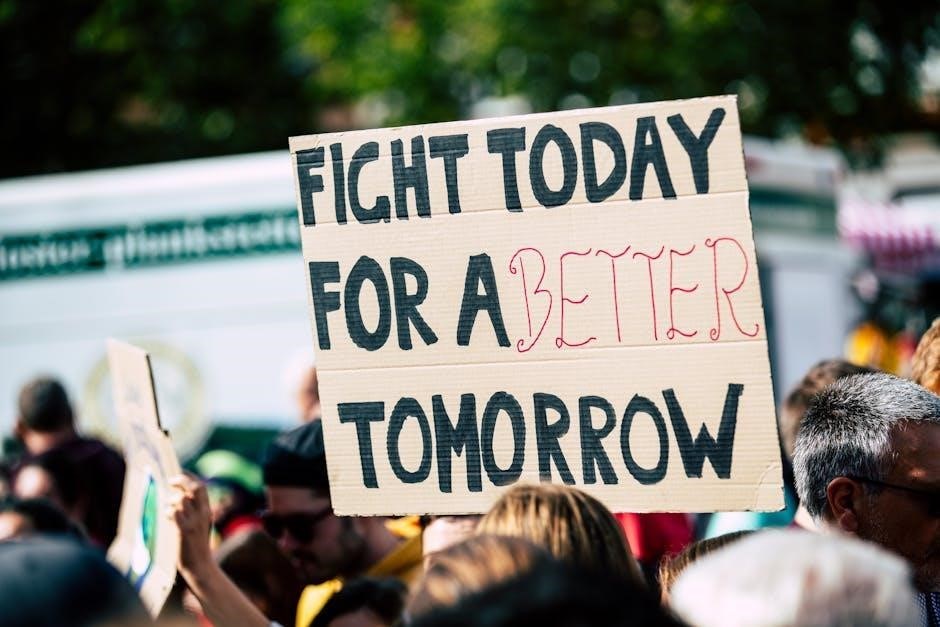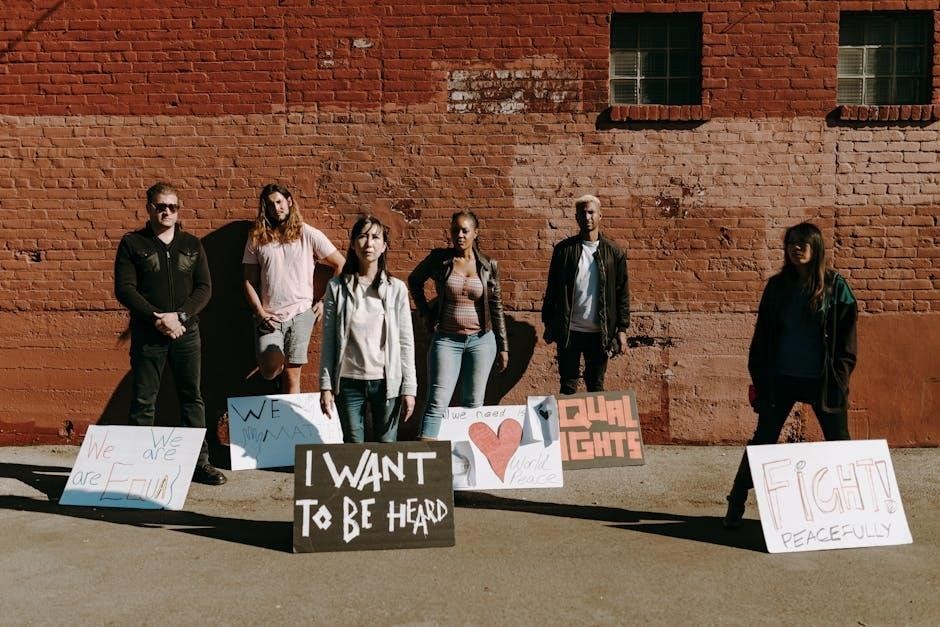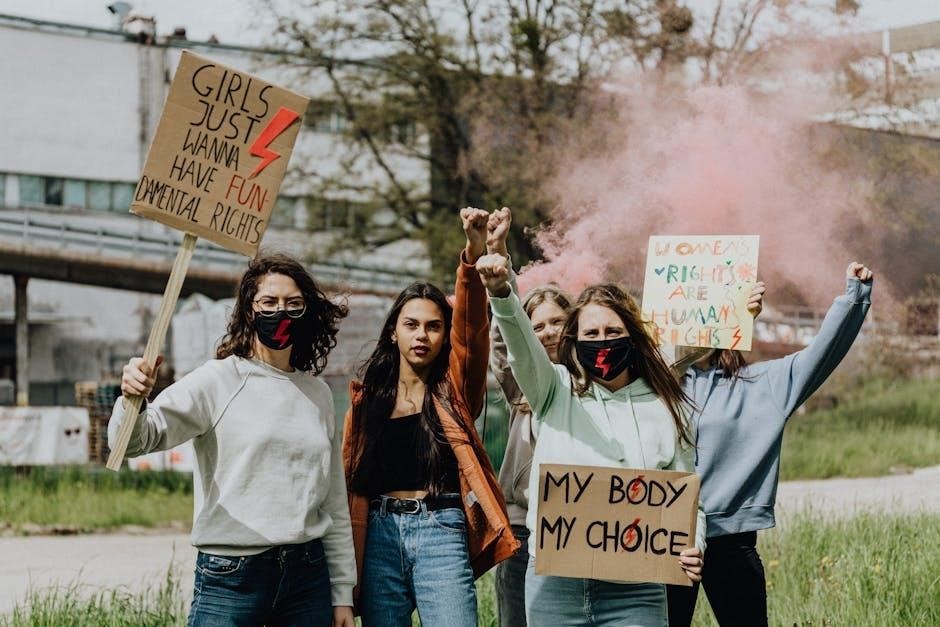Organizing for Social Change: Midwest Academy Manual for Activists
The Midwest Academy Manual is a vital resource for activists and organizers. It provides comprehensive guidance for grassroots movements. The manual covers strategies for enacting social, political, environmental, and economic change at various levels. It is valuable for nonprofit staff seeking fundraising strategies for social change.
Overview of the Manual

The Organizing for Social Change: Midwest Academy Manual for Activists serves as a comprehensive guide for individuals and groups dedicated to driving social, political, environmental, and economic transformation. This manual is designed to empower grassroots organizers with the knowledge and tools necessary for effective community action. It lays out clear, actionable steps for implementing strategies that lead to meaningful change.
This indispensable resource is beneficial for nonprofit board members, managers, founders, and employees. It offers insights into fundraising, community building, and strategic planning. The manual draws on the experiences of many activists, providing practical advice on how to organize effectively, choose relevant issues, and mobilize community support. It emphasizes the fundamentals of direct action organizing, helping individuals understand how to motivate others to seek social betterment.
Furthermore, the manual explores project management structures within organizations, offering guidance on how to optimize operations for maximum impact. It provides a framework for understanding community needs, defining organizational missions, and fostering collaboration among like-minded individuals. Whether addressing local concerns or national issues, this manual equips activists with the skills to navigate complex challenges and achieve lasting social change.
Core Principles of Direct Action Organizing
The Midwest Academy Manual emphasizes that direct action organizing hinges on several core principles. Central to these is the understanding that people are motivated to act when they are directly affected by an issue. Effective organizing, therefore, involves identifying issues that resonate deeply with community members. This approach leads individuals to want to help those affected or seek positive changes.
Another key principle is the importance of building power from the bottom up. Direct action organizing aims to empower individuals and communities to take control of their own destinies. By mobilizing collective action, ordinary people can challenge existing power structures and advocate for their rights. This approach involves creating a sense of shared purpose and building strong relationships among participants.
Furthermore, successful direct action organizing requires strategic planning and disciplined execution. It is crucial to set clear, achievable goals and develop a well-defined plan of action. This includes identifying targets, developing tactics, and building coalitions with allies. Effective communication and messaging are essential for raising awareness and garnering support for the cause. By adhering to these core principles, activists can maximize their impact and achieve meaningful social change.
Identifying and Selecting Issues
Identifying and selecting the right issue is a critical first step in any successful organizing campaign. According to the Midwest Academy Manual, the most effective issues are those that are deeply felt by a significant number of people within a community. These are often issues that directly impact people’s lives, such as access to affordable housing, quality education, or environmental protection. A good issue should also be winnable, meaning that there is a realistic chance of achieving a concrete victory within a reasonable timeframe.
The process of issue selection should involve engaging community members in a participatory way. This can be done through community meetings, surveys, and one-on-one conversations. The goal is to identify issues that people are passionate about and that they are willing to take action on. It is also important to consider the long-term goals of the organization and to select issues that align with those goals. Furthermore, the issue should be something that can be easily communicated and understood by the public.
Finally, it is essential to conduct thorough research on the issue to understand its root causes and potential solutions. This research should inform the development of a strategic plan that outlines the steps necessary to achieve the desired outcome. By carefully identifying and selecting issues, organizers can lay the foundation for a successful and impactful campaign.

Developing a Strategy
Once an issue has been identified and selected, the next crucial step is developing a comprehensive strategy. This involves creating a roadmap that outlines how the organization will achieve its goals. The Midwest Academy Manual emphasizes the importance of a well-defined strategy that takes into account the power dynamics at play and identifies key targets for change. A strong strategy should include clear objectives, measurable goals, and a timeline for implementation.
A key element of developing a strategy is identifying the “target,” the person or institution that has the power to make the desired change. The target should be carefully selected based on their ability to influence the issue and their vulnerability to pressure. The strategy should also outline a series of tactics that will be used to exert that pressure, such as public demonstrations, lobbying efforts, and media campaigns. It is important to choose tactics that are appropriate for the situation and that are likely to be effective in achieving the desired outcome.
Furthermore, a successful strategy should involve building alliances with other organizations and individuals who share similar goals. Coalitions can increase the organization’s power and resources, and can help to broaden the base of support for the issue. Finally, the strategy should be flexible and adaptable, allowing for adjustments to be made as circumstances change. Regular evaluation and reflection are essential to ensure that the strategy remains effective and that the organization is on track to achieve its goals.

Building an Organization
Building a strong and sustainable organization is paramount for long-term social change. The Midwest Academy Manual stresses that a well-structured organization provides the necessary infrastructure for activists to operate effectively. This involves defining clear roles and responsibilities, establishing decision-making processes, and developing effective communication channels. A strong organizational structure ensures that everyone is working towards the same goals and that resources are used efficiently.
Recruiting and training members are essential components of building an organization. Identifying individuals who are passionate about the issue and who possess valuable skills is crucial. Training programs should equip members with the knowledge and skills they need to be effective organizers, including communication, leadership, and advocacy skills. Creating a welcoming and inclusive environment is also vital for retaining members and fostering a sense of community.
Moreover, developing a strong leadership base is critical for organizational sustainability. Identifying and nurturing potential leaders within the organization ensures that there is a pipeline of individuals ready to take on greater responsibilities. Leadership development programs can provide training and mentorship opportunities to help these individuals grow and develop their skills. Ultimately, a well-built organization with a strong leadership base is better positioned to achieve its goals and create lasting social change.
Effective Communication and Messaging
Effective communication and messaging are crucial for mobilizing support and achieving social change. The Midwest Academy Manual emphasizes the importance of crafting clear, concise, and compelling messages that resonate with target audiences. This involves understanding the values, beliefs, and concerns of the people you are trying to reach and tailoring your message accordingly. A well-crafted message can inspire action, build solidarity, and shift public opinion.
Choosing the right communication channels is also essential. Depending on the target audience, different channels may be more effective. This could include traditional media, social media, community events, or direct outreach. It is important to use a mix of channels to reach a wider audience and reinforce your message. Furthermore, it’s key to adapt your communication approach based on the specific context and audience.

Moreover, effective communication involves listening as much as talking. Understanding the perspectives of others, even those who disagree with you, is crucial for building bridges and finding common ground. Engaging in respectful dialogue can help to break down barriers and build trust. Ultimately, effective communication and messaging are about building relationships and creating a shared understanding of the issues at stake.
Fundraising Strategies for Social Change
Fundraising is an essential component of any social change effort, enabling organizations to sustain their activities and expand their impact. The Midwest Academy Manual likely offers guidance on various fundraising strategies tailored for activists and grassroots organizations. A key principle is diversifying funding sources to avoid over-reliance on any single donor or grant.
Individual donations, both large and small, can provide a stable base of support. Online fundraising platforms, direct mail campaigns, and fundraising events are effective ways to engage individual donors. Building relationships with major donors through personal outreach and cultivation is also crucial;
Grant writing is another important fundraising skill. Researching grant opportunities from foundations and government agencies and crafting compelling proposals are essential for securing grant funding. Collaborating with other organizations on joint proposals can increase the chances of success. Furthermore, exploring earned income strategies, such as selling merchandise or offering services, can provide a sustainable revenue stream.
Transparency and accountability are paramount in fundraising. Clearly communicating how funds are used and demonstrating the impact of the organization’s work builds trust with donors. Regularly reporting on financial activities and program outcomes is essential for maintaining donor confidence.
Working with Allies and Coalitions
Building strong alliances and coalitions is vital for amplifying the impact of social change efforts. The Midwest Academy Manual likely emphasizes the importance of identifying and engaging with diverse groups and individuals who share common goals. Effective coalition building requires clear communication, mutual respect, and a shared understanding of the issues at stake.
Identifying potential allies involves researching other organizations and individuals working on related issues. Attending community meetings, conferences, and workshops can provide opportunities to connect with potential partners. Building personal relationships with key leaders and members of allied organizations is crucial for fostering trust and collaboration.
Establishing clear roles and responsibilities within the coalition is essential for effective decision-making and action. Developing a shared agenda and goals ensures that all members are working towards a common purpose. Regular communication and coordination are necessary to avoid duplication of effort and to ensure that all members are informed and engaged.
Addressing power dynamics and potential conflicts within the coalition is important for maintaining a healthy and productive working relationship. Creating a safe space for open dialogue and addressing concerns can help to resolve conflicts and build stronger bonds. Recognizing and celebrating the contributions of all members is essential for fostering a sense of unity and shared ownership.
Evaluating and Adapting Strategies
The Midwest Academy Manual likely stresses the importance of continuously evaluating the effectiveness of organizing strategies and adapting them based on the results. Regular evaluation allows activists to identify what is working well, what needs improvement, and what strategies should be abandoned altogether. This iterative process is crucial for maximizing impact and achieving long-term social change.
Evaluation should be an ongoing process, not just a one-time event. It involves collecting data on various metrics, such as the number of people reached, the level of engagement, and the outcomes achieved. This data can be gathered through surveys, interviews, focus groups, and observation. Analyzing the data allows activists to identify patterns and trends, which can inform future strategies.
Adapting strategies requires flexibility and a willingness to experiment. If a particular strategy is not producing the desired results, it may be necessary to modify it or try a different approach altogether. This may involve changing the messaging, targeting different audiences, or using different tactics. It is important to be open to new ideas and to learn from both successes and failures.
Sharing evaluation findings with allies and coalition partners can help to build collective knowledge and improve the effectiveness of social change efforts across the board. Documenting lessons learned and best practices can also help to ensure that future generations of activists can build on the successes of the past.
Case Studies in Social Change Organizing
The Midwest Academy Manual likely incorporates case studies to illustrate the practical application of its organizing principles. These real-world examples provide valuable insights into how successful social change movements have been built and sustained. Case studies can highlight the challenges faced by organizers, the strategies they employed, and the outcomes they achieved. They offer a concrete understanding of how theory translates into action.
Analyzing case studies allows activists to learn from the experiences of others. By examining the successes and failures of past campaigns, organizers can gain a deeper understanding of what works and what doesn’t. Case studies can also provide inspiration and motivation, demonstrating that social change is possible.
The case studies included in the manual may cover a range of issues and contexts, such as environmental justice, economic equality, and political reform. They may also showcase different organizing models and tactics, such as community organizing, direct action, and electoral campaigns. By studying a variety of case studies, activists can develop a broader understanding of the landscape of social change organizing.
Furthermore, the manual might encourage readers to critically analyze the case studies, considering the specific context, the actors involved, and the long-term impact. This critical analysis helps to develop a nuanced understanding of the complexities of social change and the factors that contribute to success.

